SEO can seem like the Wild West for business owners. And of course, you can find 20-step guides to everything you need to know about SEO.
And that’s great and very helpful… but for most business owners it’s just too much to comb through and implement.
That’s why we put together a busy business owners’ guide to the first step in your SEO journey, what’s that?
A site audit.
We promise it’s not as scary as it sounds and can be the most important thing you do for your business in 2024.
We’ve broken it down into action-based audit steps that are major game changers if you want your business to rise to the top of the rankings.
Think Like A Search Engine
Specifically, let’s think like Google for the moment. Google plays a non-stop game of hide-and-seek with all of the information on the internet.
The trick to making your business be found is as easy as telling Google where you’ve been hiding.
There are a few ways that you can do that, but it helps to know exactly what Google is looking for in rankings.
That’s why a site audit is so crucial. It helps us understand what Google already knows about your site and where it is currently ranked in the search results.
On-Page Keyword Targeting
A big part of any good site audit is seeing what keywords (if any) your site is currently ranking for.
This matters because keywords are the “hints” that Google needs to know what information is on your site and who should see it.
By using a tool like ahrefs.com you can simply type in your website and instantly know what organic keywords your site is ranking for.
If you’ve found what you are already ranking for, it can be an opportunity to improve on it and build from there.
If you don’t find any results for your site, this is the perfect opportunity to start implementing a keyword strategy and start ranking.
There are a few key places where you can check your on-page optimization. Let’s dive deeper into a few.
Check Your Title Tags
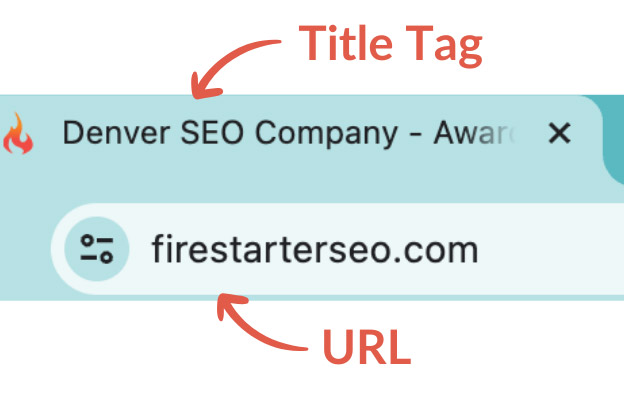
Title tags are one of the most important places to ensure keywords are locked in. Title tags may go unnoticed by the untrained eye, but Google notices them first.
By having strategic title tags, the relevance of the page and keywords are easily seen by Google.
Changing this alone can make a huge impact on organic SEO efforts. It’s a quick win and doesn’t take any real technical expertise. Simply logging into your site and changing the title tag to be relevant will make a huge improvement to your rankings.
Things to look for in a perfectly built title tag:
- Length: Under 70 characters is optimal to avoid it from being cut off.
- Structure: Begin with the main keyword, follow with a descriptive phrase, and end with your brand name.
- Intentional Keyword Placement: Use your keyword once at the beginning to create a meaningful title. If needed, you can include it once more in the middle, but no more than twice to maintain clarity.
Headings and Content Optimization
Headings have huge potential when it comes to effective SEO. Two specific things should be aligned when optimizing your headings.
1. Size Matters
It may seem trivial, and a bit nitpicky to care what size headings are set to on your website. It’s not like we are being graded on format right? Wrong. Google uses things like heading size to judge the importance of content. What do we mean by size? Think H1, H2, etc. It’s how we tell Google what’s important and what the main content is on the website.
Simply by going through and making sure that the size of your headings matches the importance of the content, you’ve made it easier for your site to be read.
Want to take a peek at your site quickly to see how things are set up?
If you’re on Google Chrome, open your website.
Maximize the browser window, right-click anywhere on the page, and choose “inspect” from the right-click menu.
Click on the bow with an arrow symbol from the top left corner of developer tools to toggle on the inspect element function.
From here you can select any element and see in the code what the size is. Go through your headings and make sure that each one is reflected by the importance of the size in the code.
This can be a little confusing because how the size appears on your website and what size it is recognized by Google as can be different.
Here’s what a “quick check” would look like on our website:
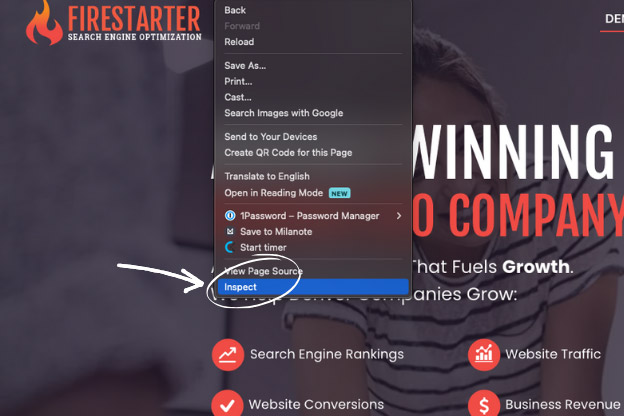
Great, now that it’s open, does our main heading have an H1 tag?
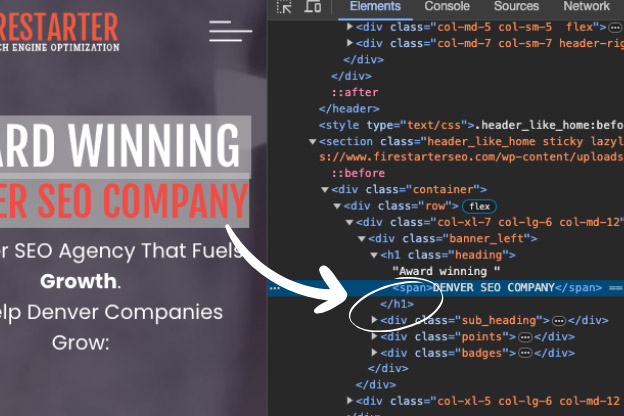
Yep, and our subheading has an H2 tag. Great!
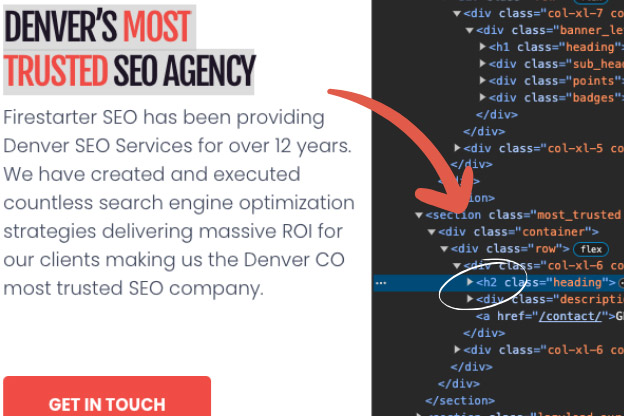
Doing this with all of your pages, and subheadings will help optimize your site. It’s also great to spot-check if you had someone else build your site, or you haven’t checked in a while.
2. Keywords In Headings
Now that you know that you know keywords matter, and you have your headings formatted, it’s time to make sure you’ve combined them as part of your audit.
This is the great part about doing an audit, you can identify places where you need to improve the SEO, then decide on a strategy for how to fix it, without jumping right in without a plan.
Remember our example, we are an SEO company called Firestarter SEO, but we also know that “Denver SEO Company” is a huge keyword for us and we want to rank, so we put that in our Title Tag and sprinkle it in naturally on our page throughout the headings.
However, there is a call for balance here, because you don’t want to keep reusing the same keyword in each heading, you’ll want to use synonyms or variations to avoid over-saturation.
If you don’t utilize keywords in your headings, it’s like having a huge wall with lighting perfect for a gorgeous piece of artwork, only to put a sticker in the middle of the wall and call it good.
So, as you look at your site do you find keywords in your headings? Are they cohesive with the purpose of your site?
As you learn to keep thinking like Google, you won’t ever see your site the same way again.
Technical SEO Made Easy
Now that you’ve optimized your site with some “low-hanging fruit”, it’s time to take a look at something that can trip up a lot of business owners; Technical SEO.
It doesn’t need to be as complicated as it sounds, it comes down to a few important aspects of your site.
Crawling Before Indexing
To understand what we mean by “crawlability” think of your website as a supermarket, with the Google crawler as a shopper.
The site’s crawlability determines how smoothly the shopper can navigate aisles (web pages), locate products, and grasp the store layout. Well-organized aisles with clear signs (navigation links) ensure a hassle-free shopping experience, making everything accessible.
Conversely, obstacles like caution tape (site errors and broken links) hinder navigation, potentially driving the shopper (crawler) away, and damaging site visibility and traffic.
If Google can’t navigate your site, it isn’t going to find your site helpful, sending it down the list of search results. Why does that matter? Crawling a website is how Google determines the site index.
After crawling, the final step is indexing, where the website’s information is stored in Google’s database for future retrieval when relevant searches are made. The efficiency and accuracy of this process depend heavily on the crawler’s ability to navigate and understand the site.
Again, a tool like ahrefs.com comes in handy. You can complete a site audit and get a “health score”.
You’ll get a result that will look something like this:

From here, you can see exactly what pages have technical issues on them and dive into fixing them.
If your site doesn’t have much in the way of technical issues, it’s a great way to know that it’s not the technical side of things that is keeping you from ranking.
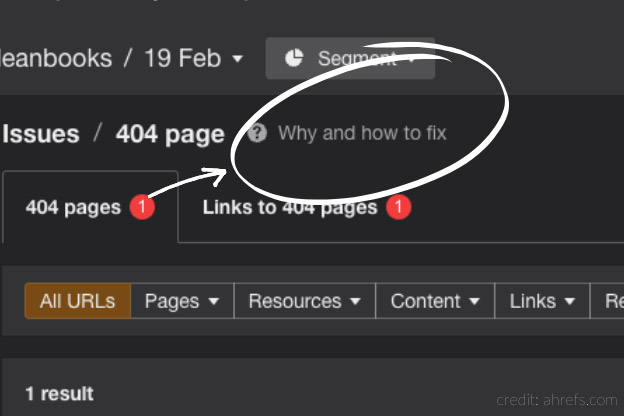
An unexpected benefit of improving crawlability is the user experience. Because the crawler treats the site like a web, by making it more crawlable you are also making it easier to navigate by target customers that now can find your site!
Look At Link Building
No site audit would be complete without a link audit. A link audit is used to see the reputation of your site based on the number and reputation of sites that have linked back to yours.
Think of a backlink as a vote for your website. The more votes of confidence your site has, the better its reputation.
Using your newfound SEO tools, it’s easy to do a quick audit of how many backlinks your site currently has.
You can also see the site rank of the site that is linked to yours. This ranking is on a scale of 1-100. The stronger the site that links back to you, the better it is for your site!
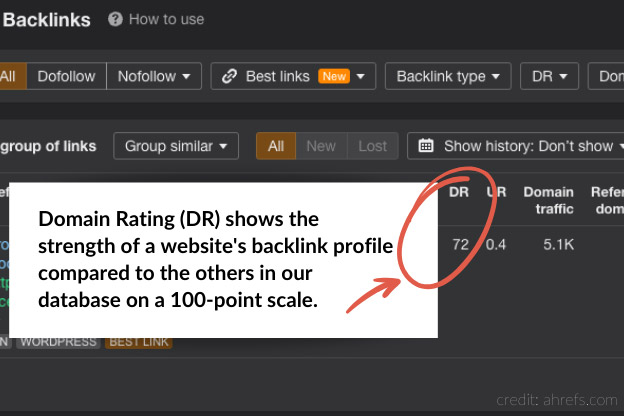
This can give you information on what type of content is valued for that subject, and also how many backlinks you’ll need to be competitive.
Just taking the average of your competitor’s backlinks can give you a starting goal and see where you are by comparison.
Learning from Competitors
Our default here at Firestarter SEO is to make sure that all of our clients stand on their own merits when it comes to SEO no matter what the competition is doing. However, there are some advantages of looking at the competitive landscape when it comes to link building.
Use SEO tools to research who is ranking for the keywords you’d like to rank better (or at all) for. Once you know who is ranking and what kind of content is in the top spot, you are much more educated on how to compete against them.
This is powerful because just by doing some research, you are finding your competitor’s keyword strategy. Since you are already doing a site audit, this is prime time to start a new strategy in direct competition with theirs, since it’s likely they aren’t following all of these suggestions.
Post-Audit Plan for SEO Success
As we’ve discovered, there are three main pieces to an informed site audit:
- On-Page Keyword Targeting
- Technical SEO
- Link Building
After going through the above action steps, it should be pretty clear what aspect of your SEO needs the most attention.
We see all the time that business owners will get this far in the process, only to feel overwhelmed when trying to implement the changes needed to rise in rankings.
Something that we’ve learned through our 14 years doing SEO, is that business owners often do best having help going through this process.
It can be daunting and overwhelming right up until the point where you bring in the right help.
Good SEO isn’t a mystery, it’s transparent and actionable. Now that you’ve uncovered how Google currently views your site, it’s critical for your business growth for you to take it to the next level.
Something we do here at Firestarter SEO is conduct free SEO audits that go through all of the steps we covered and more to make being found online easy and repeatable.
If you would like to have a full SEO audit to uncover a roadmap to exactly what changes you need to make to drive more traffic, get in touch with us.
You can take what we find and implement it yourself, or use us as expert guides so that a site audit is something you have in your arsenal regularly.
We never want any business owner to pile “fix SEO” onto their already full plate of work, instead, let’s put a checkmark next to “be at the top of search results”.
Quick Wins:
We know we covered a lot of information in this article so here is a quick checklist of quick wins to get you started:
Keyword Optimization
- Review and Update Title Tags: Ensure each page’s title tag includes targeted keywords relevant to the content.
- Optimize Headings: Incorporate primary keywords in your H1 tags and secondary keywords in H2 and H3 tags where appropriate.
Technical SEO Improvements
- Conduct a Basic Site Audit: Utilize SEO tools to identify technical issues (e.g., broken links, site errors) affecting site performance.
- Improve Site Crawlability: Fix technical issues to ensure search engines can effectively crawl and index your site.
Link Building Strategy
- Perform a Link Audit: Evaluate the number and quality of backlinks to your site.
- Seek Quality Backlinks: Identify opportunities for gaining high-quality backlinks from reputable sites in your industry.
Track SEO Performance:
- Regularly monitor your website’s SEO performance using analytics and SEO tools.
- Adjust Strategy as Needed: Be prepared to tweak your SEO strategy based on performance data and changing search engine algorithms.


